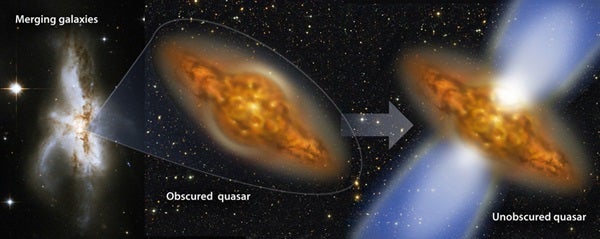Giant black holes in the centers of galaxies grow mainly as a result of intergalactic collisions, according to results presented by a group of astronomers led by Ezequiel Treister from the University of Hawaii.
As gas clouds in galaxies are sucked into the central black hole, they emit vast amounts of radiation, giving rise to objects that astronomers call quasars. “We find that these growing black holes are originally hidden by large amounts of dust,” Treister said, “but after 10-100 million years this dust is blown out by the strong radiation pressure, leaving a naked quasar that is visible in optical wavelengths and keeps shining for another 100 million years.”
For this study, the group combined data obtained with the Hubble, Chandra, and Spitzer space observatories to identify a large number of obscured, dust- enshrouded quasars at very large distances, up to 11 billion light-years away when the universe was still in its infancy. “For many years, astronomers believed that these sources were very rare,” Treister added. “Now we are seeing them everywhere!”
Because most of the emission from these obscured quasars is hidden, astronomers looked at infrared wavelengths for signs of very hot dust and in X-rays, which are less affected by obscuration. The investigators discovered that the number of obscured quasars relative to the unobscured ones was significantly larger in the early universe than it is now.
“We knew theoretically that the mergers of massive gas-rich galaxies were more frequent in the past; these observations fit very nicely within this scenario,” said Priyamvada Natarajan of Yale University.
“We knew that this is definitely the case for nearby galaxies,” said David Sanders from the University of Hawaii, “but this result shows that this happens across the universe.”
Researchers further analyzed images of these distant galaxies taken by the Hubble Space Telescope, using the new Wide Field Camera 3 installed 10 months ago during the last servicing mission. These images revealed obvious signatures of interactions and mergers, thus confirming the hypothesis of this group. Finally, using a simple theoretical prescription, the authors estimated that it takes about 100 million years for radiation from the growing black hole to wipe out the surrounding dust and gas and reveal the naked quasar.
Major galaxy mergers are important to trigger star formation episodes and modify galaxy morphologies. “This work confirms that mergers are also critical for the growth of the nuclear giant black hole,” said Natarajan. Mergers are essential for the evolution of a galaxy and cause the galaxy’s central black hole to gain weight during both the obscured and unobscured phases.










